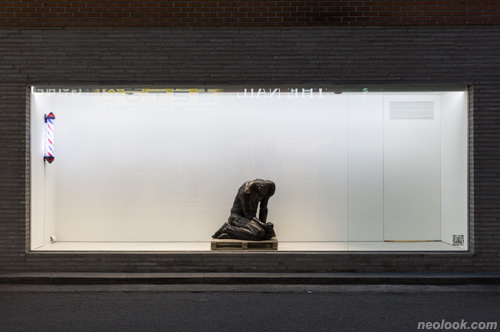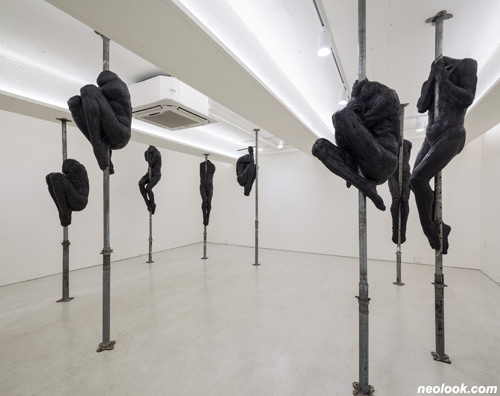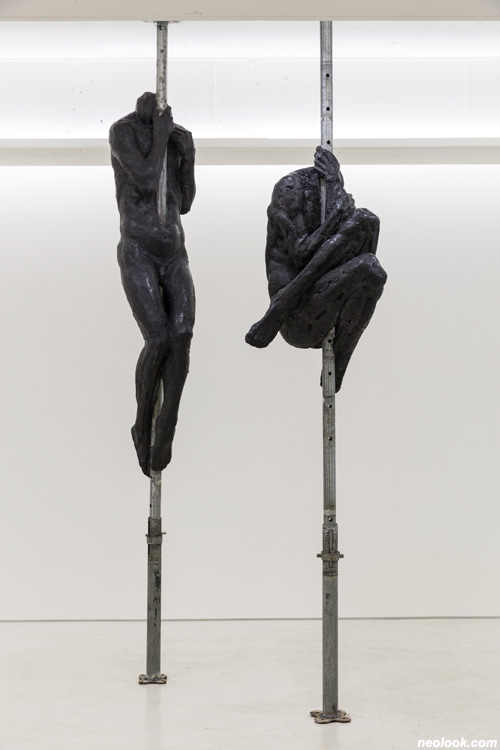- ● homepage
- ● archives
- ● restoration
- ● books
- ● big banners
- ● post board
- ■ neo's search
- ■ about us
- ■ 게재방법 안내
- 개인정보처리방침

- [email protected]
- Tel. 02_335_7922
- Fax. 02_335_7929
- 10:00am~04:30pm
- 월요일~금요일
- 3/3(월) 대체공휴일

HUMAN STAIN
황학삼展 / HWANGHAKSAM / 黄矐三 / sculpture 2018_0309 ▶ 2018_0421 / 일요일 휴관
● 위 이미지를 클릭하면 네오룩 아카이브 Vol.20161028e | 황학삼展으로 갑니다.
초대일시 / 2018_0309_금요일_05:00pm
관람시간 / 10:00am~06:00pm / 토요일_11:00am~06:00pm / 일요일 휴관
챕터 투 CHAPTERⅡ 서울 마포구 동교로27길 54(연남동 566-55번지) Tel. 070.4895.1031 www.chapterii.org
챕터투 (Chapter II)는 『휴먼 스테인 (Human Stain)』전을 2018년 3월 9일 부터 4월 21일까지 연남동 전시 공간에서 개최한다. ● 사람이나 사물의 형태나 외향에 대한 주관적인 표현을 나타내는 형용사의 어원을 추적하다보면 색, 물성, 온도 등을 나타내는 단어에서 파생된 경우가 상당히 많음을 알 수 있다. 이러한 경향은 단순히 서구 문자체계의 근원적 위치를 차지하고 있는 라틴어 뿐만 아니라 대다수의 아시아 언어권에서도 쉽게 발견된다. 흔히 인간이 가진 감각들을 '오감'이라고 통칭하는데 이 중 실질적인 신체의 접촉에 의해 감지가 일어나는 경우는 '피부감각'이 유일하다. 피부에 분포되어 있는 신경은 접촉을 통해 파악되는 온도감 및 재질의 물성, 위협 정도 등을 대뇌피질에 전달하며, 시각에서 추출된 정보와 결합하여 인지(Cognition)가 생성된다. 즉, 인간이라는 특수한 신체 기관과 형태하에서, 주어진 사물의 표면에서 감지되는 촉감과 온도, 가공 정도는 시각이 판별하는 경험지식과 결합하여 즉각적인 특정한 감정을 불러 일으킨다.

- 황학삼_Mute-기다리는사람_FRP_100×90×95cm_2018
황학삼의 일련의 인체 조각들에선 인간이 가진 오감, 특히 색과 표면의 물성이 감상(Appreciation)이라는 행위에 어떠한 연쇄작용을 일으키는지에 대한 작가의 예민한 탐구가 빛을 발한다. 거칠게 가공된 표면과 뒤틀리고 절명된 듯한 상태의 전신상과 흉부상들은 검은색이 내포하는 상징성과 결합하여 그로테스크하고 기묘한 풍경을 연출한다. 인체 외형을 따라 굴곡마다 흩뿌려지듯 자리잡고 있는 흰색의 표피들은 군데군데 표현된 양감에도 불구하고 생동감을 억제하고, 일련의 행위와 이벤트가 오랜 시간이 경과했음을 알려주는 시각적 지표로 기능한다. 어떤 행위가 있었는가에 대한 서사적 심상이 일어나기전, 이러한 일련의 장치들의 감각에 대한 직접적이고 즉각적인 호소는 작품의 형태와 의도된 구상성에 우선적으로 집중하게끔 이끈다.

- 황학삼_HUMAN STAIN展_챕터 투_2018
있었음직한 외부의 충격과 여파가 직접적으로 표현된 조각상은 일관적으로 건축용 서포트에 결사적으로 매달리거나 관통된 형태로 표현되어있다. 작품에서의 서포트는 실질적으로 조각상을 지탱하고 있는 기능 이외에도 작품에 내포된 은유와 개념의 전달 역할 또한 하고 있음이 흥미롭다. 작가의 표현대로 이 기둥들은 삶 속에서 간헐적으로 구축되는 일시적이고 불완전한 가치관으로 해석될 수 있다. 뒤 틀리고 뜯겨나간 신체의 형상은 불완전한 가치관과 함께 기거함으로 야기된 비정상적인 삶의 행로 또는 불확실한 미래 앞에 던져진 작가, 아니 우리 자신의 모습 또한 은연 중에 반영한다.

- 황학삼_HUMAN STAIN展_챕터 투_2018
서포트의 일반적인 용도와 함께 마치 흑요석으로 가공된 듯한 조각상은 상당한 무게감을 암시하는데 반해, FRP로 이루어진 조각상은 상당히 가볍게 가공되었다. '서포트와 조각상의 결합'이라는 일률적 구성으로 세워져 있는 조각상들은 언케니한 풍경을 조성하지만 공포를 유발하지는 않는데, 이는 이러한 균질한 패턴과 색의 단조로움, 시간성이 스테이징된 방식이 우리가 영화나 역사적 사건 등에서 유추될 만한 장소, 사건의 모습 보다는 비현실적이고 상당히 절제된 방식으로 보여지기 때문일 것이다. 그 보다 실제 속이 텅 비고 가벼운 조각상은 서두에서 언급한대로 육체가 비물질적인 '정신(Spirit)'에 종속되어 있고, 인간의 모든 희노애락이 이로 인함임을 상징하기도 한다. 이는, 제목이 암시하듯이, 우리가 맞닥뜨리는 조각상들이 실제 육체의 다양한 재현이 아닌 정신과 마음의 상태를 투영함으로 해석되야 함에 힘을 싣는다. ■ 챕터 투

- 황학삼_HUMAN STAIN展_챕터 투_2018
Chapter II is delighted to announce the exhibition, 'Human Stain', from 9th March to 21st April 2018 in Yeonnam-dong, Seoul. ● When one traces the origin of certain adjectives which contain a subjective expression of appearances or shapes of human and objects, she or he discovers that they often derived from words indicating colors, temperature or some physical traits. This tendency is frequently found not only in Latin language, the root of the Western lingual system, but also in the majority of Asian countries. The common designation of senses human possesses is 'five senses'; amongst these senses, 'tactile sensation' is the only case detected through actual physical contacts. Nerves of skin deliver numerous information received through touch to the brain cortex; for instance, the information includes temperature, properties of matter or the degree of multiple threats. Combined with other details acquired through the optic organs, the message enables human beings to arrive at the stage of cognition. Thus, under an unique structure of human body and organs, the data, such as tactile impression, temperature, and the level of processing, gained from a surface of a particular object instantly evokes specific emotions when it is united with empirical knowledge discerned by the sense of vision. ● In the series of human body sculptures by Hwang Hak Sam, his keen investigation into how five senses and characteristics of colors and surfaces have a sequential effect on the act of appreciating art stands out. In addition to the symbolic meaning of black, Hwang's roughly manufactured surfaces and distorted full-length or torso figures create an eccentric and grotesque landscape. Also, white layers of the surface sparsely placed on each curve along the outline of a body reduce liveliness of the work, despite some parts revealing a sense of volume. They ultimately play a crucial role of visual indicators notifying that a long time has lapsed since a chain of actions and events occurred. The straightforward and immediate appeal of these elements leads viewers to priorly concentrate on the work's shape and composition. ● Hwang's sculptures which directly demonstrate exterior influences and forces highly likely happened before, have consistent forms of desperately holding onto their architectural support, or penetrating it. The intriguing factor is that the support not only has a practical function, but also conveys implicit notions and metaphors of Hwang's practice. As the artist's explains, the pillars can be interpreted as imperfect and temporary values occasionally appeared in life. A twisted and torn-out figure of a body subtly suggests a portrait of the artist himself and also people of the present era who confront the uncertain future and abnormal life paths caused by holding the immature values. ● Along with the conventional necessity of the support, the texture of Hwang's sculptures reminiscent of obsidian implies its heaviness, however, the actual sculpture is made up of a light material, FRP(Fiber Reinforced Plastics). Hwang's sculptures presented in an uniformed composition—'the combination of sculptures and supports'—construct an uncanny landscape, yet they do not produce an atmosphere of terror immediately. It is due to regular patterns, monotonous colors and the way of staging time manifested in a mode which is moderate and less realistic than actual places and incidents referred to in historical affairs or films. Hwang's hollow and light sculptures signify that a body is subordinate to immaterial 'Spirit' and this fact brings about human emotions including joy, anger, sorrow and pleasure. Furthermore, as the titles of his work suggest, Hwang's sculptures should be interpreted as careful reflection upon states of human body and spirit rather than a mere representation of various actual bodies. ■ CHAPTERⅡ
Vol.20180329c | 황학삼展 / HWANGHAKSAM / 黄矐三 / sculpture

